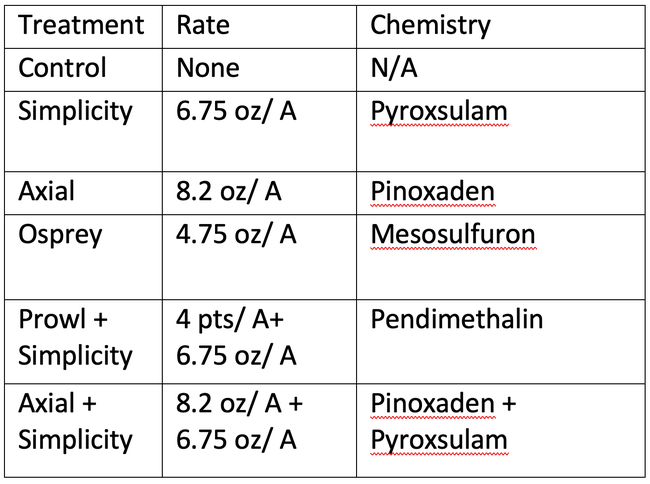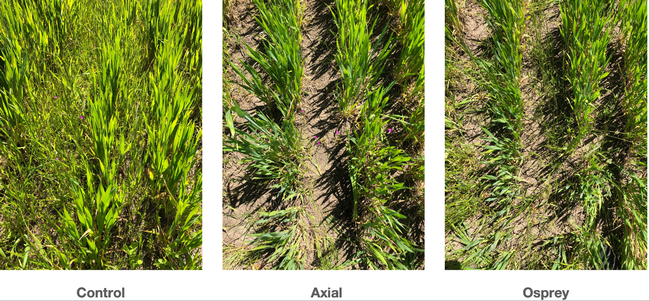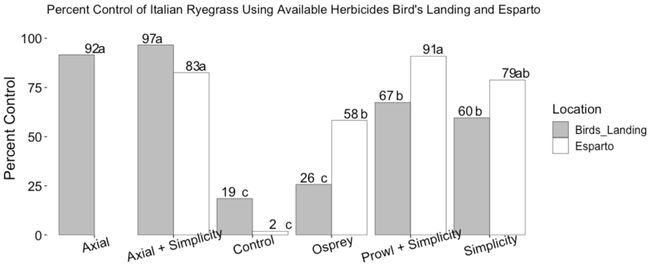Summary Review
Results from this year's Italian ryegrass (IR) herbicide trials helped quantify differences in herbicide resistance among IR populations within the southern Sacramento Valley. The trial took place in Bird's Landing, CA (near Rio Vista), and was replicated farther north in Esparto, CA.
- Trials from this year suggest that Osprey-resistant IR populations often associated with the area around Dixon, CA could extend at least as far south as Bird's Landing with only 26% control of IR by Osprey in the trial site.
- The Osprey-resistant population appears to also be moderately resistant to Simplicity, another herbicide in the same chemical family, which only provided 60% control at the Bird's Landing site.
- Axial (an ACCase inhibitor) worked well at controlling IR in Bird's Landing (92% control).
- In Esparto, IR in the trial was somewhat more susceptible to ALS inhibitors. IR control was only around 80% with Simplicity.
Introduction
For a few years I've heard PCAs mention that Italian ryegrass (IR) populations around Dixon are showing resistance to Osprey (an ALS inhibitor herbicide), but quantification of differences in weed control can help provide a better understanding of what growers are dealing with. IR is notorious for its capacity to develop herbicide resistance to multiple modes of action (MoA). As an obligate outcrossing plant, IR must cross-pollinate in order to produce viable seed. This means that genetic material is regularly exchanged during pollination, which allows populations to respond to environmental pressure. Development of herbicide resistance in IR over the years has caused increasing concern for small grain growers, who are limited in their options for control.
This study is part of a wider range of studies examining different options available to growers for IR control in small grains. This study quantifies the efficacy of various available herbicides on IR populations in small grains both in the northern parts of Yolo County and the southern parts of Solano County.
Methods
Two trials were set up: one in Bird's Landing and one in Esparto. Each plot was 15 x 100 feet and was replicated 4 times at each location. Plots were planted with wheat in late December 2022 after a burndown treatment and were treated in January of 2023 using the maximum label rate of each herbicide along with recommended adjuvants (Table 1). A 20ft x 15ft section of each plot was left unsprayed as an untreated reference. Axial was unintentionally applied at half label rate in Esparto.
Prowl was tested to see if it might improve control by by providing residual control of late germinating ryegrass that escaped preseason control efforts but did not germinate with the first fall rains. IR control was not significantly better in the Prowl tankmix vs Simplicity applied alone in this experiment.
Treatments and Rates Evaluated for Italian ryegrass Control in Two Wheat Sites in 2023 in the Sacramento Valley.
Weed counts were taken in late February in each plot (3 sub-samples). The untreated reference sections within each plot were measured once (1 representative sub-sample). Percent weed control was measured by the difference in ryegrass density within the treated and untreated areas in each plot.
Grain was hand harvested in late July using 3 x 4ft^2 quadrats in each plot. Spikes were collected by cutting the stem at the base of the spike using a sickle. Samples were then air dried. Grain yield was determined by subtracting an estimated chaff weight of 17% from the weight of the harvested spikes (McCartney et. al, 2006).
Results and Discussion
Percent control
Within each location, herbicides varied significantly in terms of the capacity to control IR.
In Bird's Landing (20 miles south of Dixon, CA), Axial provided significantly better IR control than Simplicity, Prowl + Simplicity, and Osprey. Osprey did not reduce IR populations compared to the non-treated control plots. (Figure 2)
In Esparto, a tank mix of Prowl + Simplicity provided better control of IR than Osprey but was not different than Simplicity alone (p = 0.52) or the tank mix of Axial + Simplicity (p = 0.81). Osprey provided only moderate control (58%) and was marginally different from Simplicity (p = 0.084), which provided 79% control.
The differences in control between the two ALS-inhibitor herbicides (Simplicity and Osprey) at the two locations are an indication of the variation among IR populations that are only 50 miles apart.
Yield
Yield results collected from the Bird's Landing site show trends that generally correspond with differences in weed control, although no significant differences in estimated yield were found due to the variability of the data.
Conclusion
Variations in herbicide efficacy are a good reminder that there is a lot of genetic variability in IR populations; even fields only a few miles apart could have important differences in response to herbicides. This means that grower practices can directly impact the development of herbicide resistance in their area. Growers in the Dixon area should incorporate IPM practices listed above and consider the use of Axial as an alternative weed control if they haven't already, and growers farther north should remain particularly vigilant about preserving the efficacy of their ALS inhibitor herbicides by integrating some of the IPM practices listed below.
- Using certified seed (to prevent weed seeds from hitching a ride to entirely different areas of the state)
- Thoroughly cleaning equipment, or operating equipment only within local areas to prevent the spread of weed seed to other parts of the state
- Rotating herbicides within the season and from one season to the next, where possible
- Spraying at the right time (check labels, apply on the early end of the spray window)
- Spraying the right rate (Axial applications in Esparto were sprayed unintentionally at half-rate and provided no control).
- Spraying when weeds are actively growing
- Planting wheat at the right density
- Incorporating mechanical cultivation or Harvest Weed Seed Control where possible
- Checking and calibrating spray nozzles
- Incorporate the use of pre-emergent herbicides labeled in California
- Rotating crops where possible to diversify herbicide programs
- Check for escapes and monitor fields for efficacy
Growers are also encouraged to take advantage of UC IPM resources online, and in-person through their local farm advisors.
References
McCartney, D.H.; Block, H.C.; Dubeski, P.L.; Ohama, A.J. Review: The composition and availability of straw and cha? from small grain cereals for beef cattle in western Canada. Can. J. Anim. Sci. 2006,86, 443–455.


